Chapter 2:
The Heart the Most Efficient Machine in the World
Recall the small accumulation of cells that starts moving on the left side of the 22-day-old fetus. That first movement signals a heartbeat. This collection of cells will now not stop moving for a long time. It will never grow tired. It will beat around 70 times a minute, some 35 million times a year, and some 2 trillion times during an average lifespan.82 It will pump a total of some 227 million liters (59,970,000 gallons) of blood throughout its owner's life.83
Embriyonic Heart |
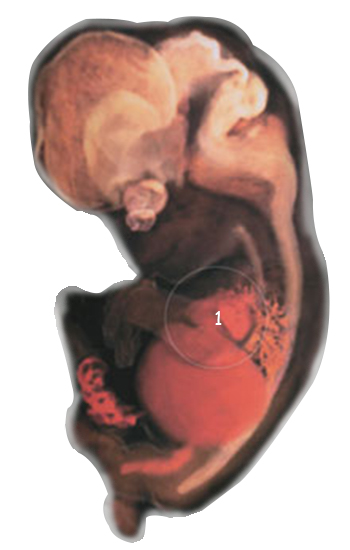 |
1. Embryonic heart The embryonic heart begins of pregnancy, and works as a single pump for the embryo's blood, which circulates only in the baby's body and the placenta. After birth, however, since oxygen is inhaled directly by means of respiration, the embryonic heart needs to possess four chambers. This physiological dichotomy has been resolved thus: Two holes in the chambers of the heart enable blood to be retained in these chambers and the as-yet-undeveloped pulmonary veins are protected. When the baby takes its first breath and begins crying, these holes automatically close and cease their function. This marvel of creation once again shows to us the flawlessness of our Lord's creation. |
This astonishing amount could fill a 10-ton tanker84 in a day, or 100 full-capacity swimming pools in a lifetime.85 And this extraordinary pump seldom misses a beat from its rhythm, and never goes wrong and becomes old. It never loses its ability to pump blood throughout the body until the death of its owner. That is because this is an extraordinary miracle of God, Who is able to create a superior artistry, flawlessness, an incomparable balance and magnificent intelligence all at once.
The fetus's heart begins beating hours before there is any blood to pump. But why should this organ start functioning before the blood is formed? The reason is the need for nutrients. The emerging embryo requires nutrients, oxygen and hormones in order to develop. In the tiny embryo, there are also waste products that have to be carried away. Therefore, this magnificent pump inspired by God suddenly begins its independent and flawless motion at just the right time and place.86
Every detail in this great miracle is sufficient for a person to have faith and see the evident proofs of God's existence. A most special creation prevails in all the features of the heart. Independently of all the other miraculous systems in the body, the heart is by itself a major example of creation in our bodies. No comparable mechanism to keep a human being alive has ever been developed. With the cells that comprise it, its special valve systems and the ordered way these open and close, the heart is a most complex system with many attributes. No other organ can do anything like the job it does—to keep pumping blood in a particularly powerful way. As long as blood is still present, the heart can even keep beating outside the body.
By beating an average of 70 times a minute, the heart moves blood around the body some 1,000 times a day. This means that blood visits every cell in the body 1,000 times a day, carries to them the necessary nutrients, gives oxygen and takes back carbon dioxide, repairs damage, makes good defects and collects wastes. Thanks to the heart's tireless efforts, every cell in the body is "inspected" 1,000 times a day. The heart pumps 8,000 liters (2,113 gallons) of blood every day.87 The heart of an adult pumps 340 liters (89 gallons) of blood an hour even while sleeping. At that same rate, one could easily fill a car's gas tank in just seven minutes.88
The heart is a piece of muscle the size of a fist, consisting of water, fat and protein, but possessing a far more perfect and complex system than even the most advanced pump that has yet been developed by experts working with computers. This incomparable piece of flesh is powerful enough to squirt blood 2 meters (6 feet) high into the air.89
Another miraculous feature is that the heart can determine the body's needs and pump just as much blood as it requires. In a person at rest, the heart pumps just 4 to 6 liters (1.057 to 1.585 gallons) of blood a minute. That quantity is enough because the resting body's cells don't require too much oxygen. If someone is exercising, however, his need for oxygen rises, and it needs to be transmitted to the cells faster. The heart immediately identifies this need and begins beating faster. During exercise, the amount of blood pumped by the heart can increase by four and seven times.90
 |
Imagine that you have set up a water system that must pump out water at least on an average of 65 to 70 times a minute, to reach around 100 trillion homes, always at the same pressure. There is no doubt that the establishment of such a plant is impossible in a great many regards. Yet inside the body there is a network system incomparably more complex than this example. The vascular network, capable of reaching every cell in the body, is another proof that the body's distribution system is flawless and conscious. |
To see the perfection of these features of the heart, imagine a machine that pumps water at least once in a second, on an average of 65 to 70 times a minute. Let that water be carried to a hundred trillion homes every second by means of that pump, under the same pressure. At the same time, let that plant determine how much water each house needs and send the requisite amount to each one. In addition, make this system be able to function for at least 70 years, never develop the slightest defect, never rust, and never neglect a single pipeline leading to any of the homes in question.
How could such a system be brought into being? It is impossible to meet the needs of 100 trillion houses under the same pressure at the same time. A machine that works at such high speed and to such an unchanging rhythm cannot last any longer than 10 or 15 years. Even before then, it will have to undergo maintenance many times to make good any defects. It is impossible for such a machine to function for long years without any mistakes. It is totally illogical to claim that an ordinary piece of equipment can determine needs in houses, evaluate the situation and send the right amount of water where required.
In addition, recall that this pump you have established is under your control or that of another rational being like you. Naturally, you cannot claim that such a mechanism and its pipelines came into being by themselves over the course of thousands of years by the coming together of iron and cement, then suddenly began rhythmically pumping water, through pipelines, laid by themselves, that will reach to 100 trillion houses. Not one person would believe it. It is obvious that the system was brought into being by an intelligent being.
However, evolutionists manage to claim that such systems as the circulatory and respiratory—incomparably more perfect than any artificial ones—came into being as the result of blind chance. They maintain that this magnificent pump, which began its work while you were still in your mother's womb, began functioning in an uncontrolled manner, as the result of chance. They ignore the clear existence of the Almighty Force to which this matchless work belongs. Yet as we shall soon examine in detail, every feature of this miraculous organ introduces us to the superior wisdom and power of God. It is revealed in verses that:
Does man reckon he will be left to go on unchecked? Was he not a drop of ejaculated sperm, then a blood-clot which He created and shaped, making from it both sexes, male and female? Is He Who does this not able to bring the dead to life? (Surat al-Qiyama: 36-40)
 |
He said, "The lord of the East and the West and everything between them if you intellect." ."(Surat ash-Shu'ara': 28) |
The Heart's Working Mechanism
The heart possesses a most systematic system, in which a single flaw can spell the end of an individual's life. The most important of the heart's mechanisms are the pumping muscles on its right and left sides: There are atria (small pumps) and ventricles (large ones) on both sides of the heart. The heart's left side—the left atrium and ventricle—is responsible for distributing oxygenated blood to the organs and tissues. The heart's right side—its right atrium and ventricle—serves to pump the "dirty" oxygen-depleted blood to the lungs to be cleaned.
When oxygenated blood reaches the heart, it is received by the left atrium, the small upper cavity. From there it is passed to the left ventricle, the large chamber below. In a similar way, deoxygenated blood is transmitted from the right atrium to the right ventricle. Although the chambers in the heart appear different, they actually perform the same job. Both are charged with pumping the blood to a specific objective.
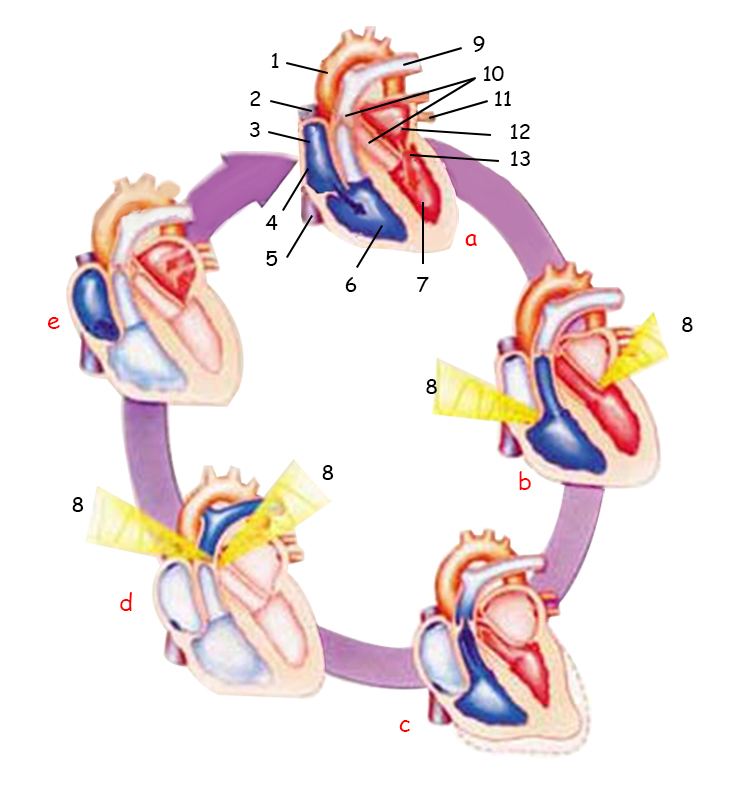 | ||
1. aorta | 6. right ventricle | 11. pulmonary vein |
Arrow indicates the direction of the blood flow. When the heart contracts, blood is passed from the atria to the ventricles. The valves close. As the ventricles contract, blood is pushed out to the body. | ||
The systematic functioning of this mechanism is of great importance because all these processes have to be in order. And if it goes wrong, the heart will either pump no blood to the body, or else it will become loaded with too much blood. In order for this sequence to occur properly, the valves between the atrium and the ventricle open like a one-way gate to the flow of blood. When the atria contract, these valves open and blood enters the ventricles. After this has taken place, the valves close again to prevent the blood's return to the atria where it came from.
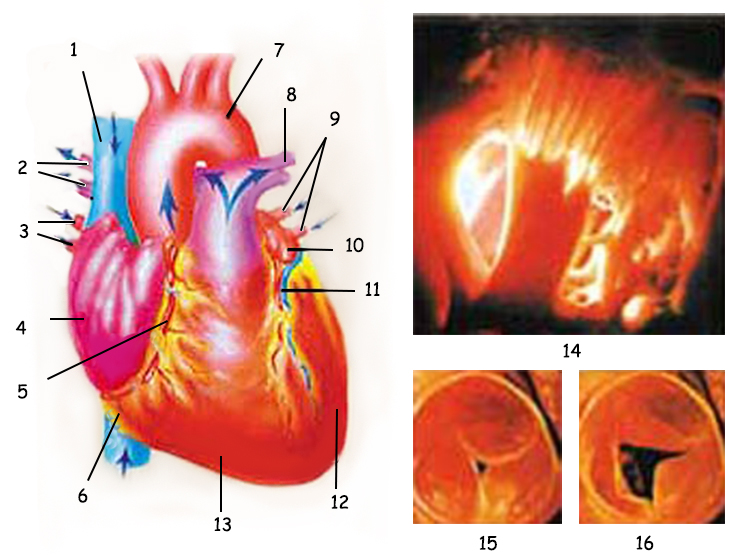 | |||
1. superior vena cava | 5. coronary artery | 9. left pulmonary veins | 13. right ventricle |
The venae cavae bring deoxygenated blood to the right side of the heart, and the pulmonary arteries carry that blood to the lungs. The pulmonary veins bring oxygenated blood from the lungs to the left side of the heart, and the aorta sends this blood to the body. During this flow of blood, the heart valves contract, thus allowing blood to pass through the chambers. | |||
Similar valves also exist in the ventricles. When the ventricles contract, these valves open and let the blood flow directly to the body. Then the valves close, preventing the pumped blood from returning to the heart. The sound that you perceive as your heartbeat does not result from the heart's contraction and dilation, as is popularly imagined. Listening to your heartbeat, you are actually hearing the opening and closing of these four powerful valves.
Leaving aside this flawless system's enormous complexity, even just the rhythmic opening and closing of the valves presents evolutionists with an enormous quandary. No living thing can afford to wait to come into possession of such a rhythmic order. The slightest lapse will cause terrible damage. The rhythmic opening and closing of the valves has to function splendidly even while the creature is still in the embryo phase. To maintain that such a movement came about through random mutations and functions in perfect manner in all vertebrates as the result of chance is a falsehood that no logical person can accept.
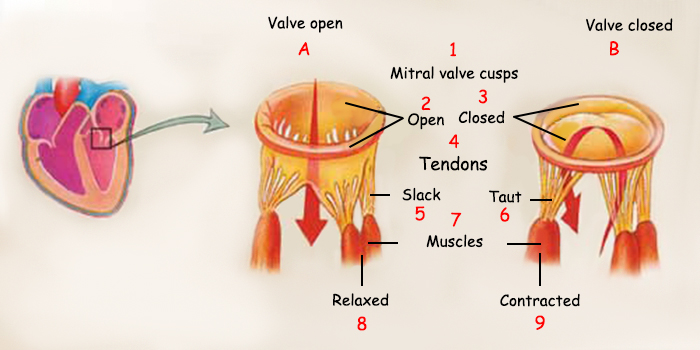 | |||
A. Valve open | 1. Mitral valve cusps | 4. Tendons | 7. Muscles |
The heart valves open in the direction of blood flow. When the atria contract, these valves (atrioventricular valves) open and blood fills the ventricles. The valves then immediately close again to prevent any blood from flowing back where it came from. | |||
The Heart Muscle Cells: The Only Ones Moving Rhythmically in the Body
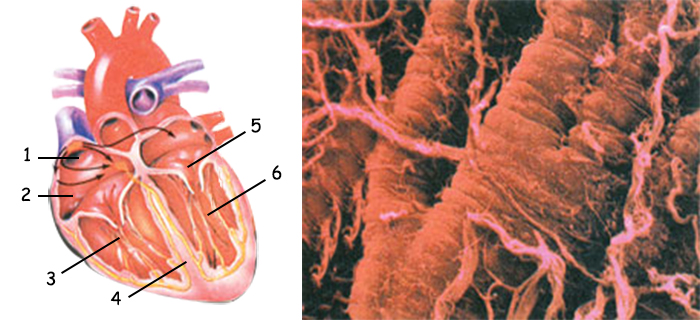 | ||
1. Pacemaker, | 3. Right ventricle, | 5. Left ventricle, |
The heartbeat is regulated by a small body of specialized heart muscle tissue known as the pacemaker, or sinus node. Below, nerve networks in the ventricle. | ||
The body consists of some 100 trillion cells, each with different functions and properties. Some, like the red blood cells, possess no nucleus. Others, like those in the windpipe, have minute hairs. Some have propulsive structures that allow them to move. Yet heart muscle cells possess an ability not found in any other in the body—the ability to shrink and expand, which is why the heart, which is made up of such cells, beats.
What makes the muscle cells in the heart special is the way they suddenly begin moving inside the still-developing embryo. These cells continue beating during transplant surgery, despite all the nerves connected to them having been severed and all contact with the organs around them having been eliminated. Indeed, even when you separate just one of these cells and place it under a microscope, it will continue to pulsate as long as you nourish it with blood.91 Despite appearing to be outside the control of any mechanism, these cells behave as if they had literally taken a decision to beat, pump blood and keep their body alive.
What allows them to beat is the electrical current that passes over them. Every cell making up the heart is literally a living battery. They themselves chemically produce the energy that powers the movement we refer to as the heartbeat. This feature of the cells is too extraordinary to be explained with any evolutionist claim. Cardiac cells provide the necessary electricity for themselves with the potassium and sodium ions that they can easily find in the blood. Each of the atoms comprising these two elements frequently loses a negatively charged electron. Consequently the atom has an extra proton, or a positive charge.
Cardiac cells possess a high concentration of potassium ions, and sodium is present in the fluid surrounding these cells. The cell membrane removes sodium from the heart muscles and takes potassium inside. Since the cell membrane removes sodium faster than it takes in potassium, an excess positive charge builds outside the cell. When it reaches a certain level, the flow suddenly reverses and sodium ions again begin entering the cells. This sudden change sets up an electrical current, and the heart cell retreats by contracting.92 The process that allows the cells to beat emerges through these chemical transactions.
The signal for the heartbeat to start depends on one small knot of cells known as the sinus node, or SA node, in the right atrium. The electrical signal produced by this node is transmitted to the heart muscle by two small muscles. The cells pass on the electrical impulse reaching them to all the other muscle cells in the heart's lower regions. This wave of current stimulates all the muscle cells beneath, starting with the right atrium, and is thus disseminated throughout the heart. The sinus node, producing and regulating these electrical currents, is also known as the pacemaker. While controlling the rhythm, the pacemaker also reacts to the needs of the body. It possesses the ability to accelerate or decelerate the heartbeat according to the body's requirements.
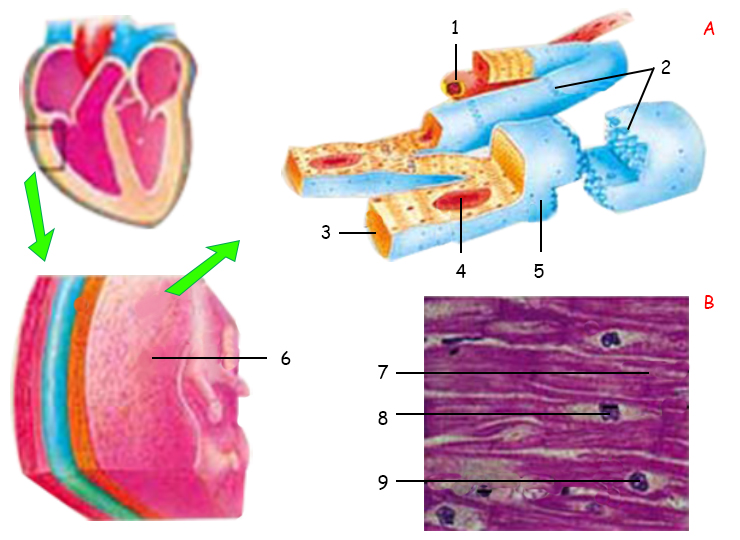 | |||
A. Diagram B. Photomicrograph | 1. Capillary | 4. Nucleus | 7. Intercalated discs |
The cardiac muscle possesses a very special structure, in that every one of the cells comprising it can beat on its own. These cells are just like living batteries, using the electrical current that passes over them. | |||
The heart does not contract all at once, however, because it has to collect blood and also to pump the blood it has collected. If all cardiac cells were to contract at once, then the blood would be pumped before it had been properly collected; and as a result, only a few drops of blood could be transmitted to the body. However the blood collected by the atria must be transmitted to the ventricles, which are larger, before the latter contract. Therefore, the cardiac muscles wait for each other to contract in sequence, just as if they were aware of their own place in line. As the cardiac muscle tissue of the atrium contracts, the valve separating the atrium from the ventricle opens and allows the blood to flow downward into the ventricle. Once the ventricle is full, it contracts. But how does that sequencing manage to remain so regular?
If you examined the cardiac cells under a microscope, one by one, you would see that each one beats at a different rate. This is a most astonishing, but also a most miraculous state of affairs: Far from being a sign of any irregularity, this actually indicates an impeccable order. The heart beats in a rhythmic and synchronized way: The cells literally know when to contract and when to expand, in line with this synchronization. God has inspired in each cell the time frame in which it will beat. That's why each beats at different speeds and sequences.93
When you put together two cardiac cells that beat at different rates, they immediately begin beating in rhythmic harmony through an extraordinary mechanism. When these intelligent cells come together, they all work in harmony and maintain a rhythm that will best pump the blood. This extraordinary fact is one of the blessings created by God for humanity. The flawless harmony between the cells is one of the proofs of our Lord's artistry. God is the Ruler of all, the Almighty.
 |
All praise belongs to God, the Lord of the Earth, Lord of all the worlds. All greatness belongs to Him in the heavens and Earth. He is the Almighty, the All-Wise." (Surat al-Jathiya: 36-37) |
The Heart Cells' Timing
 |
A cardiogram indicating the heart's electrical activity. The heart beats rhythmically and synchronically. Thanks to this regular rhythm the body is provided with the appropriate amount of blood flow. |
The impeccable order in the timing of the heart is brought about by coordination and communication among the cells that comprise it. Here again, of course, a striking intelligence manifests itself. These intelligent cells transmit current to the other side of the heart at a speed of approximately 60 centimeters (23.62 inches) a second. The signal is sent from the sinus node. The cells comprising the sinus node produce the signal in 1/14th of a second.
As the current moves rapidly, it passes through the two atria in turn and causes them to contract. Between the atria and ventricles of the heart, there is an area of specialized tissue, known as the AV node (atrioventricular node), that conducts the electrical impulse from the atria to the ventricles. Just as the electrical impulse is about to reach the ventricles, it is delayed by the AV node. The speed of the current falls to 20 centimeters (7.84 inches) a second and it starts being transmitted at around 1/16th of a second.
This delay is of the greatest importance. Due to that delay, before the ventricles contract, the atria are empty completely.94 This is the secret of the heart's synchronized action.
These are not the only notable details in the heart's electrical system. One miraculous feature of this system is the sinus node that initiates the first current. In fact, the other regions of the heart possess the same ability as the sinus node, which sets the heart muscles in motion. The AV node and the Purkinje fibers, located in the inner ventricular walls, can also set the heart in motion by setting up such a current. So why is this task left solely to the sinus node? Because the current transmitted with the sinus node is significantly faster than the others. The sinus node stimulates tissues that could set up signals of their own before these signals even begin.
Because of that speed, the sinus node initiates all electrical activity. If the current were initiated at other nodes, it would lead to blood failing to reach, or being delayed in reaching, various organs.95 The consequences would be most serious. Indeed, if blood fails to reach the brain within 4 to 5 seconds, the individual will lose consciousness. If that lack of blood is prolonged still further, it will lead to death.
Considering all these features, you can see that the heart is a conscious organ that produces its own energy and employs it to work in a most synchronized, harmonious manner. The place where movement begins is a small node consisting of a specific quantity of cells that knows how fast it has to transmit the current. Otherwise, the heart would be unable to fulfill its function and pump blood. At the same time, the heart accurately determines the amount of the current it produces. If an immeasurably minute amount of current passes through this region in an uncontrolled manner, this will cause problems that could result in death.96
In addition, the heart is able to regulate its own synchronization. Whichever of the cardiac cells, aligned side by side, has the fastest rhythm of expansion and contraction, it keeps the others in synchronization. If this rhythm is impaired—if one cell expands while another contracts—then the necessary pumping will fail to take place. The heart will soon stop and death will follow in a matter of minutes.97
In short, the heart consists of special cells that constantly produce energy, coordinate the blood flow, expand and contract under the inspiration they receive from God. They can regulate their own order, act with intelligence and can plan, calculate, and move quickly to take precautionary measures.
The Special Network that Feeds the Heart
The heart nourishes the entire body, but like all other organs, it too needs to be nourished. Because of the intensity of its work and the fact it is such a very special organ, the heart requires large quantities of oxygen and nutrients. However, the heart muscle is too thick to absorb and benefit from food and oxygen in the blood filling its chambers. Therefore, how is this valuable organ nourished?
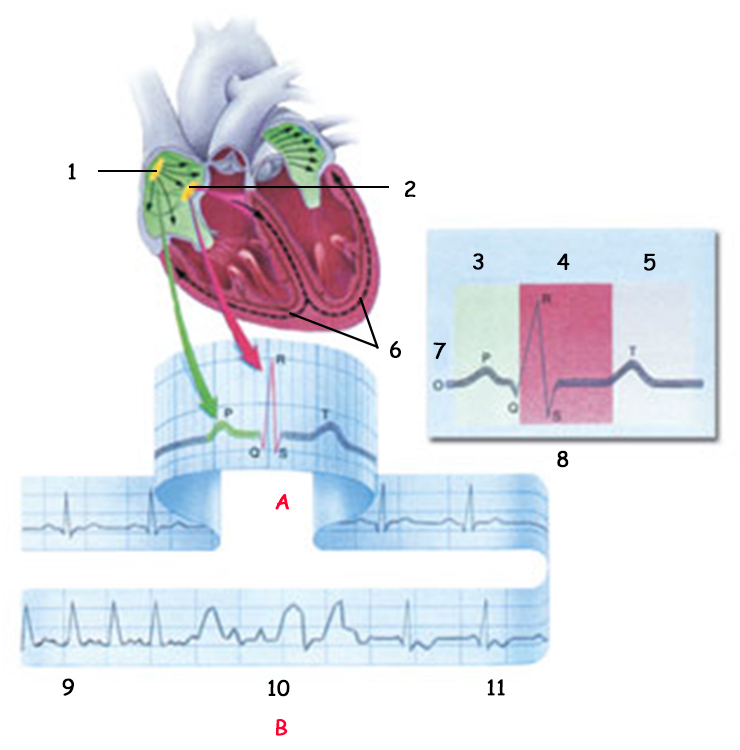 | |||
A. Normal ECG | 1. SA node | 5. Atrial/ventricular diastole | 9. Sinus tachycardia |
a) The sinus node (SA node) sends out a signal that causes the atria to contract. When this signal reaches the AV node, it sends a signal to the ventricles to contract by way of the Purkinje fibers. b) A normal ECG shows the heart is working properly. The P wave forms when the atria contract, the QRS wave when the ventricles contract, and the T wave when the ventricles are recovering from contraction. c) Abnormal ECGs: Sinus tachycardia is a rapid heartbeat due to a fast pacemaker. An irregular heartbeat occurs because of the ventricles' irregular stimulation (ventricular fibrillation). Mitral stenosis occurs because the mitral valve is obstructed. | |||
In addition to all the marvels of creation examined so far, the heart is also nourished by a special system that feeds it, known as the coronary circulation.
Of the blood that emerges from the heart by way of the coronary arteries, the heart itself is the first recipient. These arteries are two separate branches of the aorta carrying oxygen-rich blood from the lungs. These arteries have been created solely to feed the heart. Unlike all the other arteries, they leave the heart but then return to it, rather than going to other organs. In this way, the blood richest in oxygen is devoted to nourishing the heart, that region of the body needing the greatest amount of oxygen, without being diverted anywhere else. Since the heart's cells must turn oxygen and sugar into energy in order to be able to function, blood in the coronary arteries needs to be rich in these substances—because the heart's energy consumption is regulated according to need, and can raise four- or five-fold in a matter of seconds.98
The coronary arteries are perfectly equipped for their job. These arteries entering the heart separate into much smaller branches and spread throughout the heart muscle. Every cell making up the heart has a constant need for nutrients and oxygen. As these arteries head directly for the heart, they also establish sub-connections with one another, because if any of the arteries is blocked for any reason, the heart muscle will receive no nourishment and will die. These sub-connections represent a precaution taken in the face of that very grave danger. If one artery becomes blocked, thanks to that precautionary measure, blood will still flow through the others, bypass the obstruction and eventually reach the muscle tissue.
Could coincidences have taken it upon themselves to take such a precaution, before that danger was even present, by imagining the arteries becoming blocked? This is of course impossible. Coincidences are random accidents that leave no room for conscious intervention. This order, present in all living things including human beings, belongs to God, Who created them.
God reveals this in a verse of the Qur'an:
 |
Glorify the Name of your Lord, the Most High. He Who created and molded; He Who determined and guided. (Surat al-A'la: 1-3) |
 |
Say: "Have ye seen (these) 'Partners' of yours whom ye call upon besides Allah. Show Me what it is they have created in the (wide) earth. Or have they a share in the heavens? Or have We given them a Book from which they (can derive) clear (evidence)?- Nay, the wrong-doers promise each other nothing but delusions. It is Allah Who sustains the heavens and the earth, lest they cease (to function): and if they should fail, there is none - not one - can sustain them thereafter: Verily He is Most Forbearing, Oft-Forgiving." (Surah Fatir:40-41) |
Footnotes
82 Seymour Simon, The Heart - Our Circulatory System, New York: Mulberry Books, 1996, p. 1.
83 Lionel Bender, The Human Body: Its Mysteries and Marvels, Crescent Books, 1992, p. 35.
84 http://www.diyanet.gov.tr/DIYANET/nisan2001/dinsaglik.htm
85 David Burnie, "Human Body," Concise Encyclopedia, Dorling Kindersley Publishing, 1995, p. 86.
86 Robert A. Wallace, Gerald P. Senders, Robert J. Ferl, Biology Ferl 2 - Biology The Science of Life, HarperCollins College Publishers, p. 812.
87 Thema Laorusse Thematik Ansiklopedi, Vol. 4, p. 258.
88 http://people.a2000.nl/aalan/sirlar/vuc.html
90 Arthur C. Guyton and John E. Hall, Textbook of Medical Physiology, 9th Edition, Nobel Tip Kitapevi, p. 115.
91 The Incredible Machine, National Geographic Society, 1986, p. 123.
94 http://people.a2000.nl/aalan/vucut/bolum1.html, 1. Bölum: Zamanlamanin Önemi ("The Importance of Timing")
95 Textbook of Medical Physiology, Arthur C. Guyton, M.D., Seventh Edition, Nobel Tip Kitapevi, Çapa, Istanbul, p. 244.
96 http://ww.boun.edu.tr/~pubrel/news/arsiv/aralik00/aralik00.html
97 http://ww.boun.edu.tr/~pubrel/news/arsiv/aralik00/aralik00.html
- Introduction
- Chapter 1: Blood: The Incomparable Liquid of Life (1/10)
- Chapter 1: Blood: The Incomparable Liquid of Life (2/10)
- Chapter 1: Blood: The Incomparable Liquid of Life (3/10)
- Chapter 1: Blood: The Incomparable Liquid of Life (4/10)
- Chapter 1: Blood: The Incomparable Liquid of Life (5/10)
- Chapter 1: Blood: The Incomparable Liquid of Life (6/10)
- Chapter 1: Blood: The Incomparable Liquid of Life (7/10)
- Chapter 1: Blood: The Incomparable Liquid of Life (8/10)
- Chapter 1: Blood: The Incomparable Liquid of Life (9/10)
- Chapter 1: Blood: The Incomparable Liquid of Life (10/10)
- Chapter 2: The Heart the Most Efficient Machine in the World
- Chapter 3: Blood Vessels: A Flawless Transportation Network
- Chapter 4: Evolution's Impasse in the Face of the Circulatory System's Perfection
